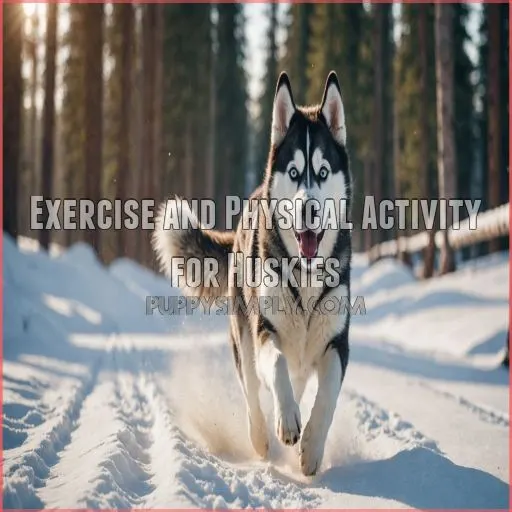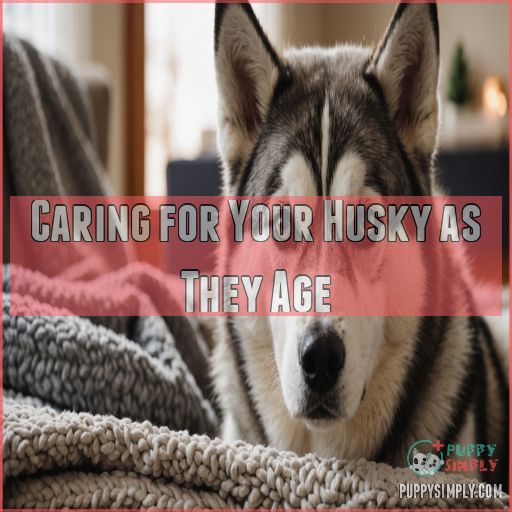This site is supported by our readers. We may earn a commission, at no cost to you, if you purchase through links.
 siberian huskies typically live between 12 to 15 years, offering you many winters of shared snowy adventures.
siberian huskies typically live between 12 to 15 years, offering you many winters of shared snowy adventures.
Their lifespan depends on factors like diet, exercise, and healthcare—kind of like us humans.
You can help extend your husky’s life by ensuring regular vet checkups and a quality diet.
Exercise is key, too, since huskies were born to run—just try keeping up!
Keep an eye out for common health issues such as cataracts or hip dysplasia.
With love, your Husky can thrive well into those golden years.
Stick around for tips on ensuring your furry friend stays by your side longer!
Table Of Contents
- Key Takeaways
- Husky Lifespan and Age Ranges
- Life Stages of a Husky
- Common Health Issues in Huskies
- Nutrition for a Long and Healthy Life
- Exercise and Physical Activity for Huskies
- Regular Vet Checkups and Preventative Care
- Extending Your Husky’s Lifespan
- Caring for Your Husky as They Age
- Maximizing Your Husky’s Quality of Life
- Frequently Asked Questions (FAQs)
- What is the leading cause of death in Huskies?
- What is considered old for a Husky?
- Can a Husky live for 20 years?
- At what age do Huskies slow down?
- What are the most common causes of death in older huskies?
- How can I monitor my huskys health as they age?
- What are the signs of cognitive decline in senior huskies?
- How can I adjust my huskys care as they transition to their senior years?
- Are there any breed-specific considerations for end-of-life care for huskies?
- Conclusion
Key Takeaways
- Diet, Exercise, and Vet Visits: Keep your Husky healthy by focusing on a balanced diet, regular exercise, and consistent vet checkups. Think of these as the Husky holy trinity for a long, tail-wagging life—just like feeding, watering, and waxing your cherished adventure mobile.
- Health Issues to Watch For: Be on the lookout for common health concerns like hip dysplasia and cataracts. Early detection is your secret weapon, much like spotting a hidden level in your favorite video game—act fast for the best outcome.
- Mental and Physical Stimulation: Huskies are like popcorn kernels—keep them jumping with plenty of exercise and mental challenges. A bored Husky might as well be a mischief-making wizard in training! Puzzle toys and agility activities are your go-tos to keep their clever minds entertained.
- Golden Years Adjustment: As your Husky matures, adjust their care to fit their senior status. Swap puppy marathons for leisurely strolls and provide comfy bedding to support their aging bones. With your love and a little TLC, they’ll thrive well into their golden years.
Husky Lifespan and Age Ranges
You’re probably wondering how long your furry friend, the Siberian Husky, will be by your side; typically, these energetic pups boast a lifespan of 12 to 15 years.
While this might seem short compared to your Netflix backlog, understanding the factors that influence their lifespan can help you cherish every moment.
Average Lifespan of Siberian Huskies
Think of Siberian Huskies as your adventure-loving pals, living it up for 12 to 15 years.
Their lifespan averages around 12 to 14 years, depending on how well they’re cared for.
Here’s a quick rundown:
- 12-14 years: Average lifespan.
- 13-15 years: With excellent care.
- 8+ years: Seniors.
- 18 years: Record holder.
Don’t we wish all our friends could stick around so long?
Factors Affecting Husky Lifespan
From the food you serve to the environment you create, numerous factors can impact your Husky’s lifespan. Prioritize their well-being with a balanced diet, ample exercise, and a stress-free home.
Responsible breeding practices and regular vet checkups also contribute to longer, healthier lives.
Your Husky’s happiness is key – give them the care they deserve.
| Factor | Impact |
|---|---|
| Diet & Nutrition | Important for long-term health |
| Exercise | At least 2 hours daily |
| Environment | Calm, enriching, low-stress |
Health Issues and Lifespan
When you’re considering how long your Husky might live, health issues play a big role.
Those furry friends can face breed-specific risks like hip dysplasia or cataracts.
Aging brings its own set of problems—think of it as the dog equivalent of creaky knees and reading glasses.
Keep them spry with regular vet care to catch issues early.
Diet and Nutrition Impact on Lifespan
While health issues can play havoc with a Husky’s life, diet is the ace up your sleeve.
Opt for a balanced husky diet with premium kibble or raw food diets, but be cautious of nutritional deficiencies or food allergies.
Proper weight management is key, and don’t skip out on senior dog food as they age.
Remember, healthy food fuels happy paws!
Life Stages of a Husky
Understanding your husky’s life stages helps maintain their health and happiness, much like managing the never-ending energy of a superhero puppy.
From a wobbly newborn to a wise senior, each stage comes with unique challenges and joys.
Each stage requires attention, care, and lots of adventures.
Neonatal Stage (0-2 Weeks)
Your newborn husky pup is a delicate bundle of joy during the neonatal stage.
At this tender age, they’ll spend most of their time sleeping, feeding, and gaining weight.
Keep a watchful eye, as this critical period lays the foundation for their future health and development.
Cherish these precious early moments!
Socialization Stage (2-16 Weeks)
The socialization stage is really important for your husky puppy’s early development. It sets the foundation for future interactions.
- Puppy Training: Use treats sparingly, like bribing a toddler with candy.
- Socialization Tips: Introduce them to new sounds without panic.
- Playtime Importance: It’s not just play; it’s discovery!
- Loving Home: Nurture, don’t smother, their independence.
Juvenile Puppy Stage (4-6 Months)
Handling the juvenile puppy stage (4-6 months) with your husky is like coaching a roly-poly toddler—full of energy and curiosity! Be consistent with positive reinforcement during puppy training to curb excessive barking or chewing on furniture, like using chew toys.
Prioritize socialization needs and health checkups, and keep playtime exciting.
A strong nutrition guide helps them grow robust and ready for adventures.
Adolescent Puppy Stage (6-12 Months)
Every adolescent husky is a bundle of energy, so prepare for antics galore! Focus on training and socialization to foster good behavior. Playtime and mental stimulation are essential, giving them a chance to use their brains.
Feed a balanced diet to support their health and nutrition. Regular grooming keeps them sleek, and consider spaying or neutering, especially if from a responsible breeder.
Adult Stage (1-7 Years)
You’ve reached the adult stage, where your Husky’s personality really shines. At this age, they’re:
- Fully trained and socialized, ready to take on new challenges.
- Susceptible to health risks like hip dysplasia, so regular vet checkups are a must.
- Energetic and need at least 2 hours of exercise daily to stay happy and healthy.
- Thriving on a balanced, high-quality diet to maintain their sleek, athletic build.
Senior Stage (8+ Years)
As your husky enters the golden years beyond age 8, adjust their care to keep them spry. They might slow down, but they’re still clever!
| Senior Husky Care | Senior Husky Diet | Senior Husky Exercise |
|---|---|---|
| Regular vet visits | High-protein meals | Gentle daily walks |
| Comfortable bed | Joint supplements | Engage in low-impact games |
| Cozy environment | Adapted portion size | Mental stimulation |
Keep them healthy and mischief-ready!
Genetics and Breeding Impact
For huskies, good breeding ethics are key.
Responsible breeders focus on genetic testing to maintain health and reduce linebreeding risks.
Think of it like matchmaking for dogs—genetic diversity helps create a strong lineage.
So, when adopting, make sure your breeder has a clean track record.
After all, a healthy start is like hitting the jackpot for your furry friend!
Lifestyle and Exercise Effects
Consider that genetics influence your husky’s longevity, but lifestyle plays a big part too. Exercise keeps huskies active and sharp. Engage them with:
- Daily outdoor adventures
- Mental enrichment games
- Stress-free playtime
- Consistent routine
- Socializing with friends
A happy husky is a healthy husky! So channel your inner drill sergeant—minus the yelling—and make exercise a daily priority to boost their zest for life.
Diet and Nutrition Importance
Your husky’s diet is the foundation for their long-term health and wellbeing.
Opt for premium kibble or a raw food diet rich in high-quality proteins, fats, and essential nutrients.
Monitor your pup’s weight, adjusting their meals as they age.
Supplements like omega-3s can also support joint and skin health.
Fuel your furry friend right for a lifetime of adventures!
Regular Veterinary Checkups and Health
You’re feeding your husky the best chow, but skipping regular vet checkups isn’t an option, either! Routine visits uncover health mysteries before they become epic sagas.
Stick to a vaccination schedule and keep parasites at bay with preventative care.
Senior huskies need more attention, with lab tests ensuring golden years aren’t just legends. Don’t let wellness become a myth!
Common Health Issues in Huskies
You’re starting a journey to keep your husky healthy, which can feel like preparing for a fun, albeit slightly chaotic, adventure.
Common health issues like hereditary cataracts, hip dysplasia, and even epilepsy can pop up along the way, but knowing about them helps turn obstacles into mere speed bumps.
Hereditary Cataracts and Blindness
As your Husky ages, hereditary cataracts can sneak in like a thief in the night, leading to potential blindness.
Early detection through regular vet visits and genetic testing is your knight in shining armor.
Breed-specific risks mean keeping an eye on your pup is essential.
Cataract surgery can restore vision—prevention tips? Provide a balanced diet and unwavering love.
Progressive Retinal Atrophy (PRA) and Blindness
Alongside cataracts, Huskies can also face the devastating effects of progressive retinal atrophy (PRA) – a genetic condition that gradually robs them of their sight.
The good news? Early detection through genetic testing can help you get ahead of this issue and explore treatment options to preserve your pup’s precious vision for as long as possible.
Hip Dysplasia and Joint Health
After tackling eye issues, we’ll discuss hip dysplasia and joint health. Early detection is key. Watch for signs like limping or stiffness, and consult your vet ASAP.
Prevention tips include:
- Regular exercise impacts joint health positively but avoid overdoing it.
- Supplements can support joint health.
- Surgery options exist for severe cases.
Keep your husky moving smoothly!
Cancer and Mortality Rates
Just like hip dysplasia shadows joint health, cancer lurks as a serious concern for huskies. They’re not invincible, after all. Early detection is your secret weapon in extending survival rates.
Keep a keen eye on symptoms, explore treatment options, and learn more about husky genetics.
Partner with your vet, embrace preventive tactics, and remember—knowledge is your best ally.
Epilepsy and Seizure Disorders
If your husky starts shaking like a leaf unexpectedly, epilepsy might be the culprit. Don’t let it pull the wool over your eyes—understanding epilepsy triggers is key.
- Know the triggers: Recognize what might set off seizures.
- Prevent panic: Keep your pup safe during episodes.
- Explore treatments: Consult a vet for epilepsy treatment options.
Nutrition for a Long and Healthy Life
Fueling your Husky’s long and healthy life starts with their diet.
A balanced, high-quality diet that meets their nutritional needs is essential – and you’ll be glad to know there are expert guidelines to help you get it right.
The Importance of a Balanced Diet
Caring for your Husky’s health means understanding their dietary needs.
A balanced diet isn’t just rabbit food—it’s the ticket to their long-term health and happiness.
Think of quality nutrition as your pup’s main squeeze for longevity.
Choose food that’s nutrient-rich and offers balanced protein, fat, and carbs to keep them energetic and ready for life’s adventures!
Role of AAFCO in Dog Food Regulation
A balanced diet isn’t all about kibble choices; understanding AAFCO standards for dog food safety keeps your husky’s health in check.
Think of AAFCO as the watchdog ensuring ingredient labeling and nutritional guidelines meet strict pet food regulation.
Safety and nutrition are their mission, making sure your furry friend stays fit and full of life—no bones about it!
Risks of Grain-Free Diets for Huskies
While grain-free diets catch the eye, they could be a wolf in sheep’s clothing for huskies.
Despite the hype, research suggests these diets might not suit every husky, leading to food sensitivities or nutritional imbalances.
Huskies with allergies might benefit, but always check with your vet.
Remember, what looks trendy might not be healthy for your pup’s nutrition.
Maintaining a Healthy Weight Through Diet
Keeping your Husky at a healthy weight is really important for their long life. A balanced diet with the right portions is the key. Opt for high-quality, protein-rich kibble or a raw food diet designed for their needs. Avoid overfeeding and monitor their weight closely. Regular exercise will also help keep them fit and trim throughout their golden years.
- Choose a nutrient-dense, high-protein dog food
- Measure portions carefully to prevent overeating
- Provide plenty of daily exercise to burn calories
- Consult your vet for personalized dietary recommendations
Exercise and Physical Activity for Huskies
If you’re looking to keep your husky happy and healthy, staying active is just as important for them as their love of snow is.
Make sure your energetic furball gets plenty of exercise, because a bored husky will redecorate your living room in ways you didn’t think were possible!
Mental Stimulation and Enrichment
Huskies are brainier than a crossword puzzle champion on a caffeine kick! They need mental stimulation like puzzle toys and training games. Try interactive feeders to challenge their minds or scent games for a sniffari adventure. Here’s a quick guide:
| Activity | Description |
|---|---|
| Puzzle Toys | Stimulates problem-solving skills |
| Training Games | Enhances obedience while having fun |
| Interactive Feeders | Makes mealtime engaging |
| Scent Games | Encourages natural tracking instincts |
| Socialization Activities | Builds confidence and reduces anxiety |
Keep their minds as active as their legs, and you’ll keep those tails wagging!
Joint Health and Exercise Needs
A husky’s joint health, just like the oil keeping the gears moving, needs attention.
Regular exercise routines are really important:
- Encourage husky agility with playful activities.
- Focus on injury prevention through gradual exercise increases.
- Adapt routines for senior dogs to protect aging joints.
- Offer joint supplements as recommended by vets.
Ensure your husky enjoys activities without straining their joints.
Daily Exercise Requirements for Huskies
Your Husky’s energy levels are off the charts, and they need at least 2 hours of exercise daily to stay happy and healthy.
From brisk walks to playtime in the yard, make sure your pup gets plenty of physical and mental stimulation.
Trust us, a tired Husky is a well-behaved Husky!
Importance of Physical Activity for Lifespan
Getting your Husky moving isn’t just about burning off energy—it’s a ticket to longevity. Picture them happier and healthier, with wagging tails and bright eyes.
Regular exercise improves joint health and boosts Husky’s overall well-being.
So, lace up those sneakers and embrace an active lifestyle with your furry friend. It’s their secret to lasting Husky health!
Regular Vet Checkups and Preventative Care
Regular vet checkups are like the oil changes your Husky needs to keep running smoothly and avoid costly repairs down the road.
By focusing on preventative care, you’ll save yourself the headache of dealing with flea circuses and other pesky issues while ensuring your furry friend lives a long, healthy life.
Vet Checkup Checklist for Huskies
While it might feel like a chore, regular vet checkups keep your husky healthy and happy.
Don’t skip vaccinations and dental care; they’re game-changers.
Think of eye exams as windows to your dog’s soul, while ear checks keep them pitch-perfect.
An ounce of prevention with parasite prevention is worth a pound of cure, ensuring freedom from pesky health issues.
Parasite Control and Prevention
Flea and tick infestations can make your Husky downright miserable.
Thankfully, preventing these pesky parasites is a breeze with monthly preventatives.
Heartworm, too, is a serious concern, but a simple monthly pill keeps your pup protected.
Stay on top of deworming, and you’ll have a happy, healthy Husky for years to come.
Spaying and Neutering Benefits
Parasite control is really important, but let’s chat about spaying and neutering. It reduces health risks and behavioral changes, adding longevity to your husky’s lifespan.
While it can be pricey upfront, think of it as investing in your furry friend’s future.
It can even improve adoption rates by tackling overpopulation.
Remember, a little surgery can bring big benefits!
Regular Grooming and Hygiene
Spaying or neutering’s all well and good, but let’s not forget regular grooming! Huskies sport a stunning coat needing your TLC. Keep that fur fabulous with weekly brushings and seasonal shedding sessions.
Dental hygiene? Non-negotiable! Trust me, an ear check and nail trim save hassle.
Bath time’s a breeze with patience and suds. You’ve got this, Super Groomer!
Extending Your Husky’s Lifespan
You want your Husky to live a long, happy life filled with tail wags and adventures.
With regular vet visits, a stress-free environment, a great diet, and plenty of exercise, you’ll keep your furry friend as healthy as a dog with two tails!
Regular Vet Visits and Checkups
Regular vet visits are the backbone of your Husky’s long and healthy life.
These checkups are your secret weapon against common Husky ailments, ensuring your furry friend thrives well into their golden years.
Stay on top of their vaccine schedule, catch any issues early, and keep their pearly whites in tip-top shape.
Providing a Stress-Free Environment
Keeping your Husky stress-free is like giving them a cozy, safe space amidst life’s chaos.
Run a calm routine and offer positive training to ease anxiety.
It’s like yoga for Huskies—soothing their souls.
Embrace patience and understanding; they’re the keys to peace.
A peaceful home works wonders for your Husky’s heart, ensuring their tail wags for years to come.
Good Diet and Nutrition for Longevity
Feeding your husky is part art, part science.
Think: quality kibble, raw food diets, and homemade recipes.
Don’t let food sensitivities trip you up; they’ve got more quirks than a soap opera.
Senior Huskies can benefit from nutritional supplements to support their aging bodies.
Remember, a happy husky with a balanced diet is like Santa with a new sleigh—unstoppable!
Regular Exercise and Physical Activity
A Husky’s boundless energy is like a storm in a teacup, making sure they’re always on the go.
- Daily Walks: Two hours to stretch those legs.
- Mental Stimulation: Puzzles and toys for a sharp mind.
- Joint-Friendly Activities: Swimming’s gentle yet effective.
- Safety First: Make sure you have a secure play area to explore.
Caring for Your Husky as They Age
As your furry friend enters their golden years, it’s important to adjust their care to meet their changing needs.
From tailoring their diet to creating a comfortable environment, learn how to help your senior Husky thrive in their twilight years.
Senior-Specific Diet and Nutrition
A healthy diet is a must for extending your husky’s lifespan.
Senior Huskies thrive on a diet rich in nutrients that meet their changing needs.
Keeping a keen eye on weight management and food sensitivities is key.
Consider recipes that boost joint support and overall health.
Think of it as feeding your wise old furry sage the hero’s diet they deserve!
Managing Health Issues in Senior Huskies
Your senior Husky needs a balanced diet and special care to keep arthritis at bay.
Eye health can be tricky at this age, so regular checkups are a must.
Dental care’s no joke either—a rotten tooth can make even a Husky cry!
Treat your old friend like royalty, and you’ll keep tails wagging and spirits high.
Providing a Comfortable and Safe Environment
Creating a comfortable and safe space for your aging husky is like giving them their own slice of paradise. After managing their health, shift focus to creating a cozy environment.
- Soft, supportive bedding
- Quiet, draft-free resting area
- Secure outdoor spaces
- Familiar, enriched surroundings
- Regularly clean their space
Your husky will appreciate the comfort and security during their golden years.
Adjusting Exercise and Activity Levels
As your Husky ages, their exercise needs will change.
Dial back the intensity but keep them moving – a leisurely stroll or gentle playtime can do wonders.
Remember, moderation is key.
Overexerting a senior pup can backfire, so listen to their cues and adjust accordingly.
With the right balance, you’ll keep that tail wagging for years to come.
Maximizing Your Husky’s Quality of Life
To maximize your husky’s quality of life, focus on creating a strong bond with them through engaging training and fun activities.
Remember, a happy husky is a healthy husky, so make sure they’ve a safe, loving environment filled with mental stimulation and plenty of tail-wagging joy.
Building a Strong Bond Through Training
As Huskies age, they might become a bit set in their ways, but training can still help enhance your bond.
Embrace their pack mentality with positive reinforcement during obedience training and socialization.
Early training pays off, but it’s never too late.
Remember, a strong bond is like tying a balloon to your wrist—keeps them close but lets them soar.
Providing Mental Stimulation and Enrichment
A Husky’s mind can be compared to an engine—always running, keen for a challenge.
Keep your Husky’s gears turning with puzzles and interactive toys. Try out scent work or tackle agility courses together.
Socialization is key; it’s not just about sniffing butts, it’s about bonding. Keep those mental wheels turning, and they’ll thrive!
Creating a Safe and Loving Environment
Crafting a Husky-friendly home is key. Designate safe play areas indoors and out, with soft bedding and enrichment toys. Reduce stress by minimizing loud noises and providing a calm, predictable routine. Socialize your pup early on for confidence. Positive training builds trust and strengthens your bond – a recipe for a happy, healthy Husky.
- Establish designated safe play areas both indoors and outdoors, outfitted with soft bedding and engaging enrichment toys.
- Minimize exposure to loud noises and maintain a predictable, calming routine to help reduce stress and anxiety.
- Prioritize early socialization to build your Husky’s confidence and comfort in various environments and with new people.
- Embrace positive reinforcement training methods to cultivate trust, strengthen your bond, and encourage desirable behaviors.
Prioritizing Your Husky’s Well-being and Happiness
Keeping your Husky happy and healthy? It’s a walk in the park! Engage in regular socialization and Husky training for a confident pup.
Use stress management techniques to create a calm environment.
Grooming tips help them look snazzy, and healthy treats are the cherry on top.
Remember, your tender care is the heartbeat of their happiness and well-being.
Frequently Asked Questions (FAQs)
What is the leading cause of death in Huskies?
Picture life as a thrilling race, where cancer stealthily passes Huskies at the finish line.
It cleverly lurks as the leading cause of death, turning runways of health into cautionary tales.
Be vigilant, my friend.
What is considered old for a Husky?
For Huskies, hitting 14 years is like reaching the top of Mount Everest—it’s considered old.
They’ve journeyed gracefully through life’s trails and wagged their tails through the highs and lows, earning their well-deserved senior status.
Can a Husky live for 20 years?
Wondering if your Husky could reach 20 years?
While extremely rare and not officially recorded, who’s to say it’s impossible?
Some Huskies have lived up to 18 or 19 years, so aim for the stars! (Source).
At what age do Huskies slow down?
Huskies typically start slowing down around 7-9 years old as they enter their senior years. With proper care and exercise, your husky can remain active well into their teens. (Source)
What are the most common causes of death in older huskies?
You won’t believe it, but about 10% of Huskies face cataracts that might lead to blindness.
Cancer and hip dysplasia are common culprits of death, but regular checkups can help manage risks.
How can I monitor my huskys health as they age?
As your husky ages, keep a close eye on their energy levels, appetite, and mobility.
Regular vet visits are a must—like bi-annual wellness checks.
Keep them active, but don’t run them ragged!
What are the signs of cognitive decline in senior huskies?
Did you know 68% of older dogs experience cognitive decline?
Keep an eye out for disorientation, sleep changes, or lack of interest in play and walks.
If they’re wandering like a lost tourist, it’s time for a vet visit.
How can I adjust my huskys care as they transition to their senior years?
As your husky enters their golden years, adjust their diet to a senior formula.
Provide softer bedding to help keep them comfortable.
Schedule more frequent vet visits to catch any health issues early.
With a little extra TLC, they’ll thrive in their twilight years.
Are there any breed-specific considerations for end-of-life care for huskies?
When push comes to shove, prioritize quality time for your senior Husky, ensuring comfort and calm.
Keep vet visits regular, manage pain effectively, and cherish each day.
Huskies require nurturing care and love, especially in their twilight years.
Conclusion
Like a marathon runner keeping pace, your Husky can enjoy a long, fulfilling journey by your side.
With up to 15 years of husky adventures, maintaining a balanced diet, plenty of exercise, and regular vet visits is key to ensuring they’re around for all of life’s memorable moments.
So, if you’re asking "how long do huskies live," remember that with care and love, your husky’s lifespan becomes a strong reflection of your partnership’s energy and joy.















